2023年人教版中考英语一轮教材复习 第2讲 Units4-6课件(共31页)
文档属性
| 名称 | 2023年人教版中考英语一轮教材复习 第2讲 Units4-6课件(共31页) |  | |
| 格式 | pptx | ||
| 文件大小 | 1.1MB | ||
| 资源类型 | 试卷 | ||
| 版本资源 | 通用版 | ||
| 科目 | 英语 | ||
| 更新时间 | 2023-02-01 18:26:14 | ||
图片预览


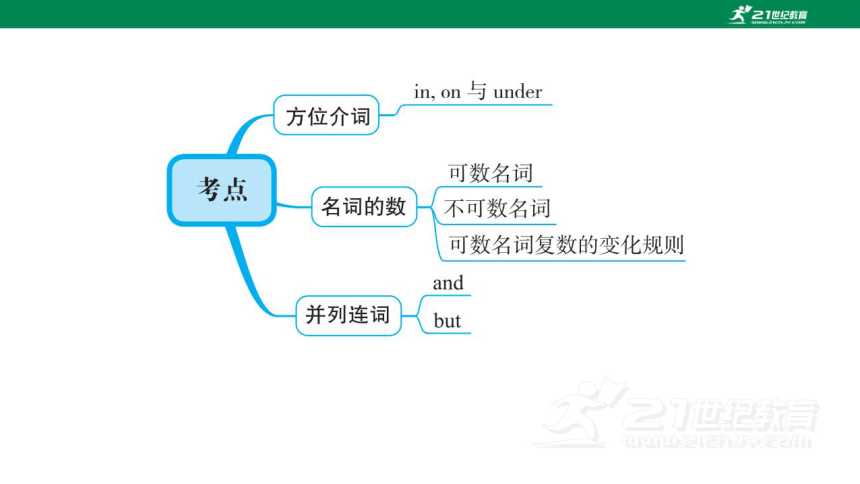

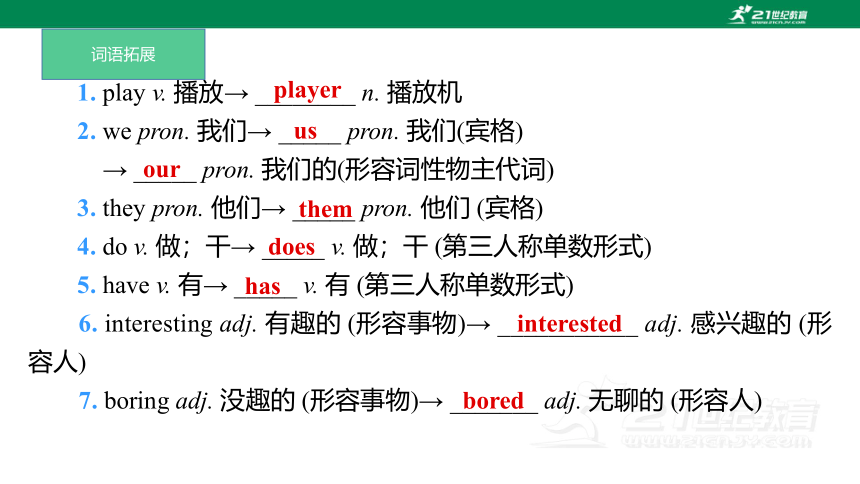
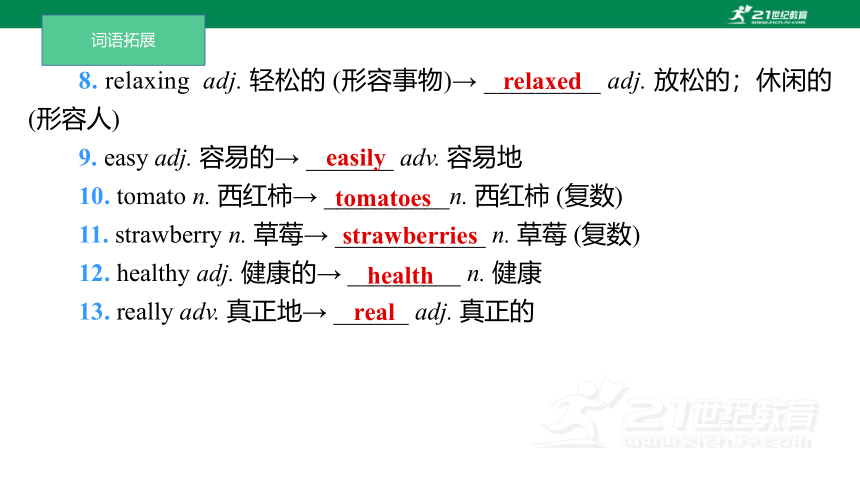
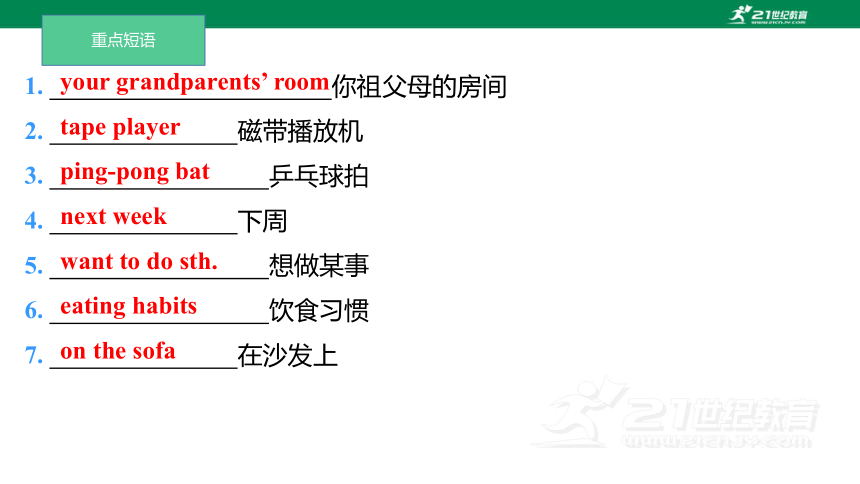
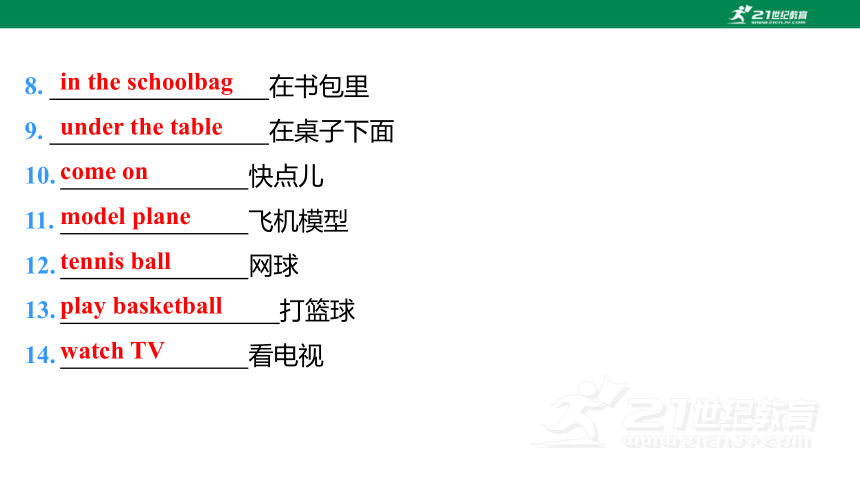
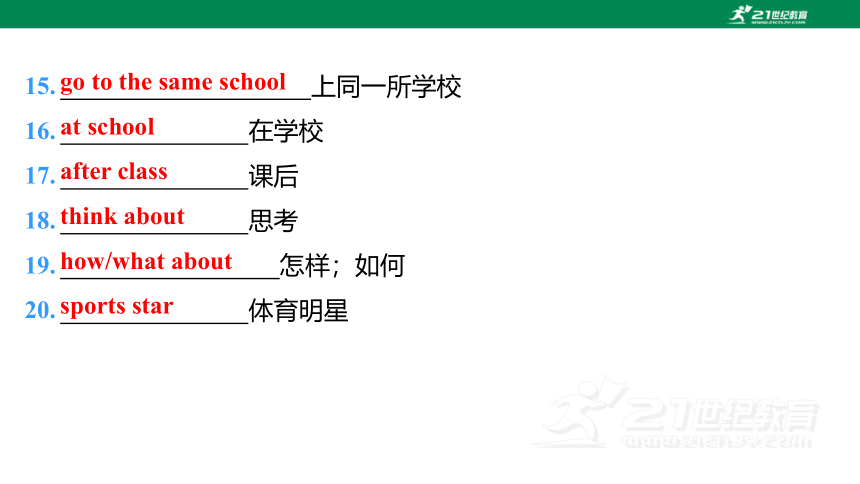
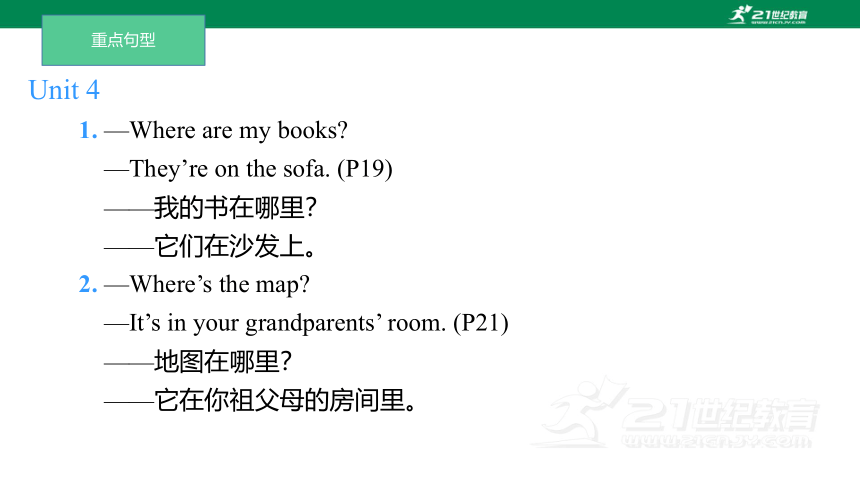
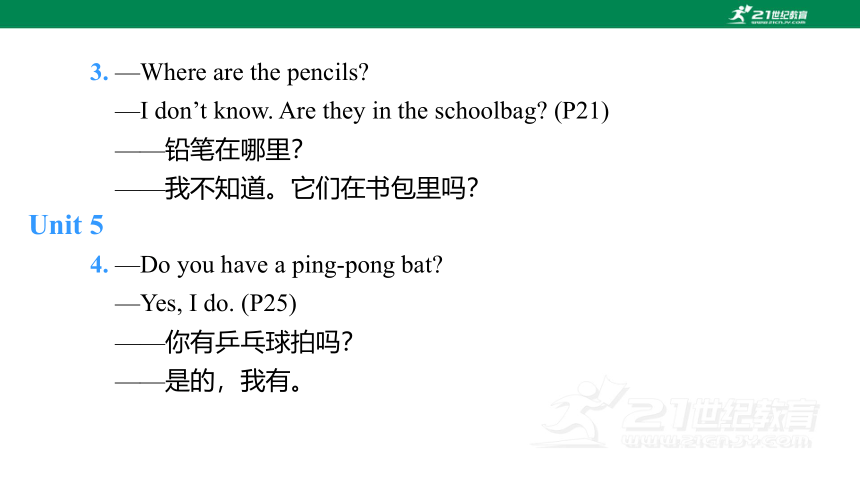
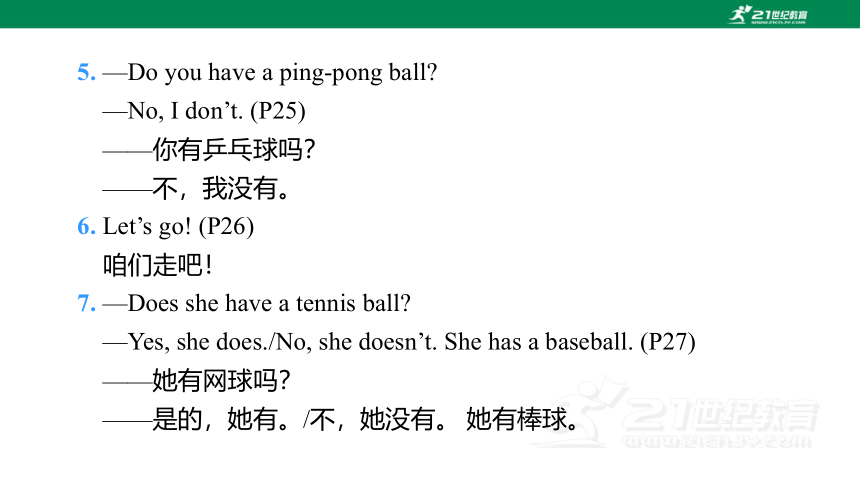
文档简介
(共31张PPT)
第一部分 七年级(上册)
第2讲 Units 4~6
2023年中考一轮复习
1. play v. 播放→ ________ n. 播放机
2. we pron. 我们→ _____ pron. 我们(宾格)
→ _____ pron. 我们的(形容词性物主代词)
3. they pron. 他们→ _____ pron. 他们 (宾格)
4. do v. 做;干→ _____ v. 做;干 (第三人称单数形式)
5. have v. 有→ _____ v. 有 (第三人称单数形式)
6. interesting adj. 有趣的 (形容事物)→ ___________ adj. 感兴趣的 (形容人)
7. boring adj. 没趣的 (形容事物)→ _______ adj. 无聊的 (形容人)
player
us
our
them
does
has
interested
bored
词语拓展
8. relaxing adj. 轻松的 (形容事物)→ _________ adj. 放松的;休闲的 (形容人)
9. easy adj. 容易的→ _______ adv. 容易地
10. tomato n. 西红柿→ __________n. 西红柿 (复数)
11. strawberry n. 草莓→ ____________ n. 草莓 (复数)
12. healthy adj. 健康的→ _________ n. 健康
13. really adv. 真正地→ ______ adj. 真正的
relaxed
easily
tomatoes
strawberries
health
real
词语拓展
1.
你祖父母的房间
your grandparents’ room
2.
磁带播放机
tape player
3.
乒乓球拍
ping-pong bat
4.
下周
next week
5.
想做某事
want to do sth.
6.
饮食习惯
eating habits
7.
在沙发上
on the sofa
重点短语
8.
在书包里
in the schoolbag
9.
在桌子下面
under the table
10.
快点儿
come on
11.
飞机模型
model plane
12.
网球
tennis ball
13.
打篮球
play basketball
14.
看电视
watch TV
15.
上同一所学校
go to the same school
16.
在学校
at school
17.
课后
after class
18.
思考
think about
19.
怎样;如何
how/what about
20.
体育明星
sports star
Unit 4
1. —Where are my books
—They’re on the sofa. (P19)
——我的书在哪里?
——它们在沙发上。
2. —Where’s the map
—It’s in your grandparents’ room. (P21)
——地图在哪里?
——它在你祖父母的房间里。
重点句型
3. —Where are the pencils
—I don’t know. Are they in the schoolbag (P21)
——铅笔在哪里?
——我不知道。它们在书包里吗?
Unit 5
4. —Do you have a ping-pong bat
—Yes, I do. (P25)
——你有乒乓球拍吗?
——是的,我有。
5. —Do you have a ping-pong ball
—No, I don’t. (P25)
——你有乒乓球吗?
——不,我没有。
6. Let’s go! (P26)
咱们走吧!
7. —Does she have a tennis ball
—Yes, she does./No, she doesn’t. She has a baseball. (P27)
——她有网球吗?
——是的,她有。/不,她没有。 她有棒球。
8. That sounds good. (P27)
那听起来不错。
Unit 6
9. I don’t like tomatoes. (P32)
我不喜欢西红柿。
10. —Do you like salad
—Yes, I do./No, I don’t. (P33)
——你喜欢沙拉吗?
——是的,我喜欢。/不,我不喜欢。
11. —Does she like tomatoes
—Yes, she does./No, she doesn’t.(P33)
——她喜欢西红柿吗?
——是的,她喜欢。/不,她不喜欢。
12. What do you like for breakfast (P35)
你早餐喜欢吃什么?
考点1 方位介词 in, on 和 under。
考点2 并列连词 and 和 but。
考点3 可数名词与不可数名词。
考点1 方位介词 in, on 和 under。
1. in 意为 “在……里”,通常表示在某一空间里。
2. on 意为“在……上”,指贴于物体的正上面。
3. under 意为“在……下”,指在物体的正下方。
1. The picture _____ (在……上) the wall is very beautiful.
on
2. Alice is reading a book _________ (在……下) the tree.
under
考点2 并列连词 and 和 but。
1. and。
(1)意为“和”,连接两个名词、代词或两个形容词等语法作用相同的词语。但否定句中用 or。例如:
It is cold and dry today. 今天的天气寒冷干燥。
I have no brother or sister. 我没有兄弟姐妹。
(2)意为“然后”,用于连接两个有时间先后的句子。例如:
After dinner, I wash the dishes and dry them.
晚饭后,我洗碗,然后把它们擦干。
(3) 意为“只要……就会……”“如果……那么……”,用于祈使句之后,表示条件与结果的关系。例如:
Study hard, and you’ll make progress.
只要你努力学习,你就会取得进步。
2. but。
(1)意为“但是”“可是”“而”“却”, 表示语义的转折。例如:
He is not feeling well, but he still keeps working.
他不舒服,但仍然坚持工作。
(2)用在表示歉意的话之后,引起一个分句,这时 but 在汉语中通常不译。例如:
Excuse me, but can you tell me how to get to the Science Museum
打扰了。你能告诉我怎样去科技馆吗?
注意: but 不与 although/though (“虽然,尽管”)连用,即在同一个句子中, 用了 but 就不能再用 although/though,用了 although/though 就不能再用 but。例如:
Though he is only 5 years old, he knows a lot.
He is only 5 years old, but he knows a lot.
虽然他只有5岁,可是他懂的东西很多。
1. Tom _____ Peter are good friends.
A. and B. but
C. or
A
2. I like running, _____ my sister doesn’t like it.
A. and B. so
C. but
C
考点3 可数名词与不可数名词。
1. 可数名词。
可数名词是指能以数目来计算,可以分成个体的事物。可数名词有单复数之分,可用数词进行修饰。例如:
a banana 一根香蕉 two bananas 两根香蕉
2. 不可数名词。
无法一个一个数出来的名词,就叫作不可数名词。不可数名词没有单复数之分,不能用数词修饰。
3. 可数名词复数的变化规则。
(1)一般在词尾加-s。例如:
pear—pears chair—chairs
(2)以 s, x, sh, ch 结尾的名词,一般在词尾加-es。例如:
bus—buses box—boxes
brush—brushes watch—watches
(3)以“辅音字母+y”结尾的名词,把 y 变为 i, 再加-es。例如:
baby—babies family—families
(4)部分以 f 或 fe 结尾的名词,把 f 或 fe 变为 v,再加-es。例如:
leaf—leaves wife—wives
(5)以 o 结尾的名词变为复数时,加-s 或-es。例如:
photo—photos radio—radios
zoo—zoos potato—potatoes
tomato—tomatoes hero—heroes
(6)不规则变化。例如:
foot—feet tooth—teeth
man—men woman—women
child—children mouse—mice
(7)单复数同形的名词。例如:
fish sheep Chinese deer Japanese
1. I visited the Science Museum last week and took lots of ________ (photo) there.
photos
2. Look! There are many ________ (child) playing happily in the garden.
children
一、单项选择。
B
C
1. —_____ is my schoolbag
—It’s on the sofa.
A. How B. Where
C. What color
2. I like rock music, _____ my sister doesn’t like it.
A. and B. or
C. but
3. —Nanning is a beautiful city.
—Yes, it lies _____ the south of Guangxi.
A. in B. on
C. to
4. Boys and girls, please get to school on time. Don’t be _____.
A. late B. rude
C. shy
A
A
5. —I run in the park every day.
—Wow! That’s a good _____. It keeps you healthy.
A. match B. task
C. habit
6. Fruit is good for us, so I often have breakfast with one _____.
A . ice cream B. egg
C. apple D. hamburger
C
C
谢谢
21世纪教育网(www.21cnjy.com)
中小学教育资源网站
兼职招聘:
https://www.21cnjy.com/recruitment/home/admin
第一部分 七年级(上册)
第2讲 Units 4~6
2023年中考一轮复习
1. play v. 播放→ ________ n. 播放机
2. we pron. 我们→ _____ pron. 我们(宾格)
→ _____ pron. 我们的(形容词性物主代词)
3. they pron. 他们→ _____ pron. 他们 (宾格)
4. do v. 做;干→ _____ v. 做;干 (第三人称单数形式)
5. have v. 有→ _____ v. 有 (第三人称单数形式)
6. interesting adj. 有趣的 (形容事物)→ ___________ adj. 感兴趣的 (形容人)
7. boring adj. 没趣的 (形容事物)→ _______ adj. 无聊的 (形容人)
player
us
our
them
does
has
interested
bored
词语拓展
8. relaxing adj. 轻松的 (形容事物)→ _________ adj. 放松的;休闲的 (形容人)
9. easy adj. 容易的→ _______ adv. 容易地
10. tomato n. 西红柿→ __________n. 西红柿 (复数)
11. strawberry n. 草莓→ ____________ n. 草莓 (复数)
12. healthy adj. 健康的→ _________ n. 健康
13. really adv. 真正地→ ______ adj. 真正的
relaxed
easily
tomatoes
strawberries
health
real
词语拓展
1.
你祖父母的房间
your grandparents’ room
2.
磁带播放机
tape player
3.
乒乓球拍
ping-pong bat
4.
下周
next week
5.
想做某事
want to do sth.
6.
饮食习惯
eating habits
7.
在沙发上
on the sofa
重点短语
8.
在书包里
in the schoolbag
9.
在桌子下面
under the table
10.
快点儿
come on
11.
飞机模型
model plane
12.
网球
tennis ball
13.
打篮球
play basketball
14.
看电视
watch TV
15.
上同一所学校
go to the same school
16.
在学校
at school
17.
课后
after class
18.
思考
think about
19.
怎样;如何
how/what about
20.
体育明星
sports star
Unit 4
1. —Where are my books
—They’re on the sofa. (P19)
——我的书在哪里?
——它们在沙发上。
2. —Where’s the map
—It’s in your grandparents’ room. (P21)
——地图在哪里?
——它在你祖父母的房间里。
重点句型
3. —Where are the pencils
—I don’t know. Are they in the schoolbag (P21)
——铅笔在哪里?
——我不知道。它们在书包里吗?
Unit 5
4. —Do you have a ping-pong bat
—Yes, I do. (P25)
——你有乒乓球拍吗?
——是的,我有。
5. —Do you have a ping-pong ball
—No, I don’t. (P25)
——你有乒乓球吗?
——不,我没有。
6. Let’s go! (P26)
咱们走吧!
7. —Does she have a tennis ball
—Yes, she does./No, she doesn’t. She has a baseball. (P27)
——她有网球吗?
——是的,她有。/不,她没有。 她有棒球。
8. That sounds good. (P27)
那听起来不错。
Unit 6
9. I don’t like tomatoes. (P32)
我不喜欢西红柿。
10. —Do you like salad
—Yes, I do./No, I don’t. (P33)
——你喜欢沙拉吗?
——是的,我喜欢。/不,我不喜欢。
11. —Does she like tomatoes
—Yes, she does./No, she doesn’t.(P33)
——她喜欢西红柿吗?
——是的,她喜欢。/不,她不喜欢。
12. What do you like for breakfast (P35)
你早餐喜欢吃什么?
考点1 方位介词 in, on 和 under。
考点2 并列连词 and 和 but。
考点3 可数名词与不可数名词。
考点1 方位介词 in, on 和 under。
1. in 意为 “在……里”,通常表示在某一空间里。
2. on 意为“在……上”,指贴于物体的正上面。
3. under 意为“在……下”,指在物体的正下方。
1. The picture _____ (在……上) the wall is very beautiful.
on
2. Alice is reading a book _________ (在……下) the tree.
under
考点2 并列连词 and 和 but。
1. and。
(1)意为“和”,连接两个名词、代词或两个形容词等语法作用相同的词语。但否定句中用 or。例如:
It is cold and dry today. 今天的天气寒冷干燥。
I have no brother or sister. 我没有兄弟姐妹。
(2)意为“然后”,用于连接两个有时间先后的句子。例如:
After dinner, I wash the dishes and dry them.
晚饭后,我洗碗,然后把它们擦干。
(3) 意为“只要……就会……”“如果……那么……”,用于祈使句之后,表示条件与结果的关系。例如:
Study hard, and you’ll make progress.
只要你努力学习,你就会取得进步。
2. but。
(1)意为“但是”“可是”“而”“却”, 表示语义的转折。例如:
He is not feeling well, but he still keeps working.
他不舒服,但仍然坚持工作。
(2)用在表示歉意的话之后,引起一个分句,这时 but 在汉语中通常不译。例如:
Excuse me, but can you tell me how to get to the Science Museum
打扰了。你能告诉我怎样去科技馆吗?
注意: but 不与 although/though (“虽然,尽管”)连用,即在同一个句子中, 用了 but 就不能再用 although/though,用了 although/though 就不能再用 but。例如:
Though he is only 5 years old, he knows a lot.
He is only 5 years old, but he knows a lot.
虽然他只有5岁,可是他懂的东西很多。
1. Tom _____ Peter are good friends.
A. and B. but
C. or
A
2. I like running, _____ my sister doesn’t like it.
A. and B. so
C. but
C
考点3 可数名词与不可数名词。
1. 可数名词。
可数名词是指能以数目来计算,可以分成个体的事物。可数名词有单复数之分,可用数词进行修饰。例如:
a banana 一根香蕉 two bananas 两根香蕉
2. 不可数名词。
无法一个一个数出来的名词,就叫作不可数名词。不可数名词没有单复数之分,不能用数词修饰。
3. 可数名词复数的变化规则。
(1)一般在词尾加-s。例如:
pear—pears chair—chairs
(2)以 s, x, sh, ch 结尾的名词,一般在词尾加-es。例如:
bus—buses box—boxes
brush—brushes watch—watches
(3)以“辅音字母+y”结尾的名词,把 y 变为 i, 再加-es。例如:
baby—babies family—families
(4)部分以 f 或 fe 结尾的名词,把 f 或 fe 变为 v,再加-es。例如:
leaf—leaves wife—wives
(5)以 o 结尾的名词变为复数时,加-s 或-es。例如:
photo—photos radio—radios
zoo—zoos potato—potatoes
tomato—tomatoes hero—heroes
(6)不规则变化。例如:
foot—feet tooth—teeth
man—men woman—women
child—children mouse—mice
(7)单复数同形的名词。例如:
fish sheep Chinese deer Japanese
1. I visited the Science Museum last week and took lots of ________ (photo) there.
photos
2. Look! There are many ________ (child) playing happily in the garden.
children
一、单项选择。
B
C
1. —_____ is my schoolbag
—It’s on the sofa.
A. How B. Where
C. What color
2. I like rock music, _____ my sister doesn’t like it.
A. and B. or
C. but
3. —Nanning is a beautiful city.
—Yes, it lies _____ the south of Guangxi.
A. in B. on
C. to
4. Boys and girls, please get to school on time. Don’t be _____.
A. late B. rude
C. shy
A
A
5. —I run in the park every day.
—Wow! That’s a good _____. It keeps you healthy.
A. match B. task
C. habit
6. Fruit is good for us, so I often have breakfast with one _____.
A . ice cream B. egg
C. apple D. hamburger
C
C
谢谢
21世纪教育网(www.21cnjy.com)
中小学教育资源网站
兼职招聘:
https://www.21cnjy.com/recruitment/home/admin
